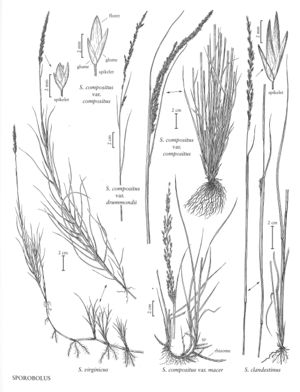Sporobolus clandestinus
Plants perennial; cespitose, occasionally rhizomatous. Culms 40-130 (150) cm tall, 1-4 mm thick, frequently glaucous. Sheaths with sparsely hairy apices, hairs to 3 mm, not conspicuously tufted; uppermost sheaths 0.5-3 mm wide; ligules 0.1-0.4 mm; blades 4-23 cm long, 1.5-4 mm wide, flat or involute, abaxial surface glabrous or pilose, adaxial surface glabrous or scabridulous, margins glabrous. Panicles terminal and axillary, 5-11 cm long, 0.04-0.2 (0.3) cm wide, with 10-40 spikelets per cm2, narrow, sometimes spikelike, included in the uppermost sheath; lower nodes with 1-2 (3) branches; primary branches 0.4-5 cm, appressed, spikelet-bearing to the base; secondary branches appressed; pulvini glabrous; pedicels 0.3-3.5 mm, appressed, glabrous or scabridulous. Spikelets 4-9 (10) mm, stramineous to purplish-tinged. Glumes subequal, lanceolate, membranous to chartaceous, midveins usually greenish; lower glumes 1.5-6.2 mm; upper glumes (2) 2.5-5 (6.5) mm, slightly shorter or longer than the lemmas; lemmas (2.2) 3-7 (7.4) mm, lanceolate, chartaceous and opaque, minutely appressed-pubescent or scabridulous, occasionally 2-veined or 3-veined, acute to obtuse; paleas (2.2) 3-9 (10) mm, ovate to lanceolate, chartaceous; anthers 2.2-3.2 mm, yellow to orangish. Fruits (1.5) 2.4-3.5 mm, ellipsoid, laterally flattened, often striate, reddish-brown; pericarps loose, but neither gelatinous nor slipping from the seeds when wet. 2n = unknown.
Distribution
Del., D.C., Wis., W.Va., Fla., N.J., Tex., La., Tenn., N.C., S.C., Pa., N.Y., Va., Ala., Ark., Ill., Ga., Ind., Iowa, Conn., Md., Kans., Okla., Mo., Miss., Ky., Mass.
Discussion
Sporobolus clandestinus grows primarily in sandy soils along the coast and, inland, along roadsides. In the southeastern United States, it is found in dry to mesic longleaf pine-oak-grass communities and cedar glades. Its range lies entirely within the Flora region.
Selected References
None.
Lower Taxa
"decumbent" is not a number.
